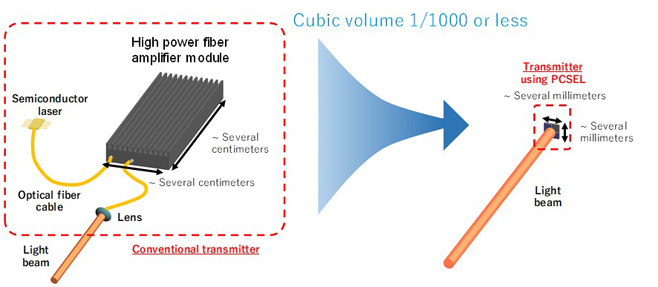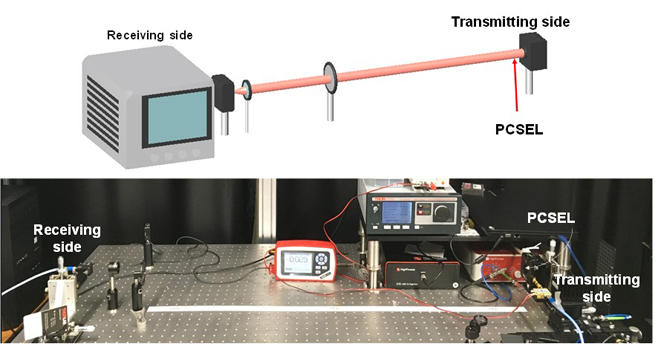 Print
Print
- Advanced Technology Laboratories
World's First Successful Demonstration of High-Power Free-Space Optical Communication Using Photonic-Crystal Surface-Emitting Lasers (PCSELs)
~Toward the Use of Communications in Space Beyond the 5G/6G Era~
September 22, 2022
KDDI Research, Inc.
Kyoto University
KDDI Research, Inc. (head office at Fujimino-shi, Saitama; Hajime Nakamura, President and CEO: hereinafter "KDDI Research") and a research group led by Professor Susumu Noda, Research Fellow Ryohei Morita, and Assistant Professor Takuya Inoue of the Graduate School of Engineering, Kyoto University have successfully demonstrated(Note 1) the world's first high-power free-space optical communication(Note 2) using photonic-crystal surface-emitting lasers (PCSELs)(Note 3). Currently, high-power free-space optical communication requires large transmitters that contain many optical components such as fiber amplifiers and lenses. By contrast, a PCSEL can achieve the same level of optical power output using only a single device, making it possible to significantly reduce the size of and simplify the transmitter system. Further research and development will be carried out with the aim of using high-power free-space optical communication in space beyond the 5G/6G era.

Figure 1 A conventional transmitter and a transmitter based on a PCSEL
【Background】
Generally, high-power emission is required to transmit light over a long distance, which necessitates the use of a large device, such as a fiber amplifier, for optical amplification. A small beam-spread angle is needed in addition to high power. A laser beam emitted through devices such as the aforementioned fiber amplifier is usually emitted from a small area. However, the size of the emission area is inversely proportional to the beam-spread angle, which results in an extremely wide beam spread (>10°) during propagation in space. A complex external optical system must be used to control the beam spread, which increases the complexity of the device and thereby the system size. Therefore, we have been conducting research and development on free-space optical communications using photonic-crystal surface-emitting lasers (PCSELs), which have a high power and narrow spread angle and can be used without a lens.
【Demonstration Results】
KDDI Research and Kyoto University have successfully demonstrated free-space optical communication using a PCSEL. Light detection and ranging (LiDAR)(Note 4) using a PCSEL has been previously demonstrated, but this study is the world’s first demonstration of the use of a PCSEL in telecommunications.
The PCSEL used in this demonstration is a single semiconductor device with an extremely high output power (≥W), which obviates the use of a large device, such as a conventional fiber amplifier. Unlike ordinary semiconductor lasers, the PCSEL emits light over an extremely large area in a single mode, resulting in an extremely small beam-spread angle of 0.1° or less, and can be emitted directly into space without the use of an external lens system. These two features simplify the transmitter configuration considerably.
We performed an experiment in which an 864-MHz 64QAM(Note 5) OFDM(Note 6) signal was emitted from a PCSEL at a power of 1 watt and successfully transmitted over a distance of 1.1 meters. This result shows the possibility of realizing free-space optical communications equivalent to 5 gigabits per second using a PCSEL.

Figure 2 Demonstration experiment
These results were presented as a post-deadline paper(Note 7) at ECOC 2022 (the European Conference on Optical Communication, which was held from September 18-22, 2022), the world’s largest international academic conference in the field of optical communication, at which a careful selection of the latest results was presented.
【Future】
We will achieve higher power and faster free-space optical communications using PCSEL and promote research and development of optical transmission technology that supports communications in space beyond the 5G/6G era.
■ KDDI Research Activities
KDDI and KDDI Research have developed a next-generation society concept "KDDI Accelerate 5.0" for the year 2030 and have written a white paper on how to materialize this concept using both the "future vision" and "technology" considered necessary to foster an ecosystem for innovation in the beyond 5G/6G era.
KDDI and KDDI Research will promote research and development of seven technologies and a corresponding orchestration technology to achieve a novel lifestyle. The results of this demonstration fall under the "Network" category of the seven technologies.
■ Kyoto University Activities
The Center of Excellence for Photonic-Crystal Surface-Emitting Lasers at Kyoto University will promote social implementation of PCSELs in a wide range of fields, such as smart mobility, smart processing, and optical communications, thereby contributing to the realization of an ultra-smart society.
(Note 1) KDDI Research demonstrated the world’s first successful use of high-power free-space optical communication using PCSELs in a survey on 22 September 2022.
(Note 2) Free-space optical communication
This optical communication technology is based on light propagation through free space, such as air and outer space, and wireless data transmission for communication.
(Note 3) Photonic-crystal surface-emitting laser
This semiconductor laser is based on two-dimensional photonic crystals, which consist of artificial optical nanostructures in a two-dimensional configuration. Unlike ordinary semiconductor lasers, a beam with a high power and narrow spread angle can be realized because a single-mode oscillation is produced over a large area.
(Note 4) Light detection and ranging (LiDAR)
LiDAR is an acronym for light detection and ranging, a remote sensing technology that uses laser light. In recent years, LiDAR has attracted attention as an essential technology for self-driving robots and automobiles.
(Note 5) 64QAM modulation
A type of modulation that transmits a signal with multiple information streams (= multiplexing) by changing and adjusting the amplitudes of two waves (sine and cosine waves) that are out of phase by 90° in 23 = 8 states and can carry (23)2 = 26 = 64 states (= 6 bits) of information per cycle. As the modulation bandwidth is 864 MHz, a total of 864 MHz x 6 bits = 5.2 gigabits of information can be transmitted per second. The higher the bandwidth is, the more information can be sent.
(Note 6) OFDM
OFDM is the acronym for orthogonal frequency division multiplexing, a modulation technique that superimposes multiple sine waves of different frequencies during the multiplexing process described in Note 5.
(Note 7) Post-deadline papers
These papers are accepted after the regular submission deadline. Papers are selected during the conference, and only highly rated research results are published.
※The information contained in the articles is current at the time of publication.Products, service fees, service content and specifications, contact information, and other details are subject to change without notice.